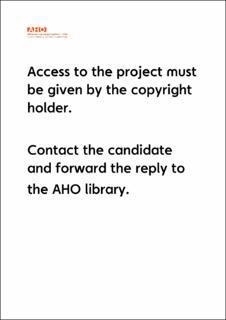| dc.contributor.advisor | Tolfsen, Ane Sønderaal | |
| dc.contributor.advisor | Groba, Ute | |
| dc.contributor.author | Gresslien, Marte | |
| dc.date.accessioned | 2023-02-23T09:26:16Z | |
| dc.date.available | 2023-02-23T09:26:16Z | |
| dc.date.issued | 2022-12 | |
| dc.identifier.uri | https://hdl.handle.net/11250/3053507 | |
| dc.description | Outdoor life has several mental and physical benefits, which is one of the reasons recreational cabins are widely used in Norway. I have looked into ways of making a shared cabin in Nordmarka, accessible without the use of a car, focusing on both social and environmental sustainability.
The project proposes a number of strategies for minimizing the impact and emissions connected to building a cabin, with a big emphasis on reuse timber. It includes selection of site, source of building material, and the way the material is utilized for maximal potential. The cabin’s constructive segments both allow for building and expanding the cabin in several stages, and allow for using (and heating) only the sections that are required for any number of visitors. | en_US |
| dc.language.iso | eng | en_US |
| dc.publisher | The Oslo School of Architecture and Design | en_US |
| dc.rights | Navngivelse-Ikkekommersiell-DelPåSammeVilkår 4.0 Internasjonal | * |
| dc.rights.uri | http://creativecommons.org/licenses/by-nc-sa/4.0/deed.no | * |
| dc.subject | Architecture | en_US |
| dc.subject | Arkitektur | en_US |
| dc.subject | Hytter | en_US |
| dc.subject | Cabins | en_US |
| dc.subject | Friluftsliv | en_US |
| dc.title | Back to the Roots: The Circular City Cabin | en_US |
| dc.type | Master thesis | en_US |
| dc.description.version | submittedVersion | en_US |
| dc.rights.holder | Marte Gresslien | en_US |
| dc.subject.nsi | Architecture and design: 140 | en_US |



